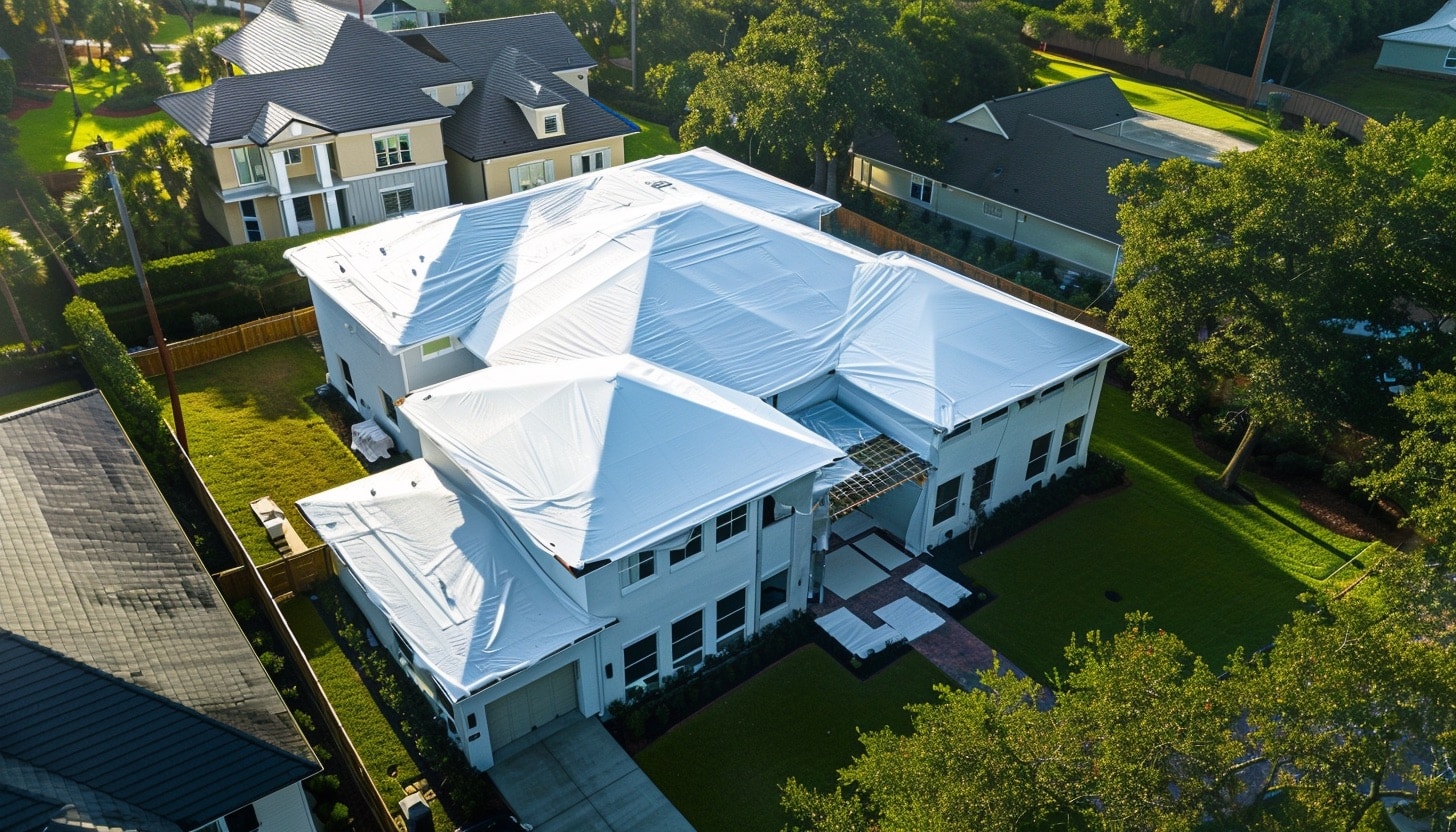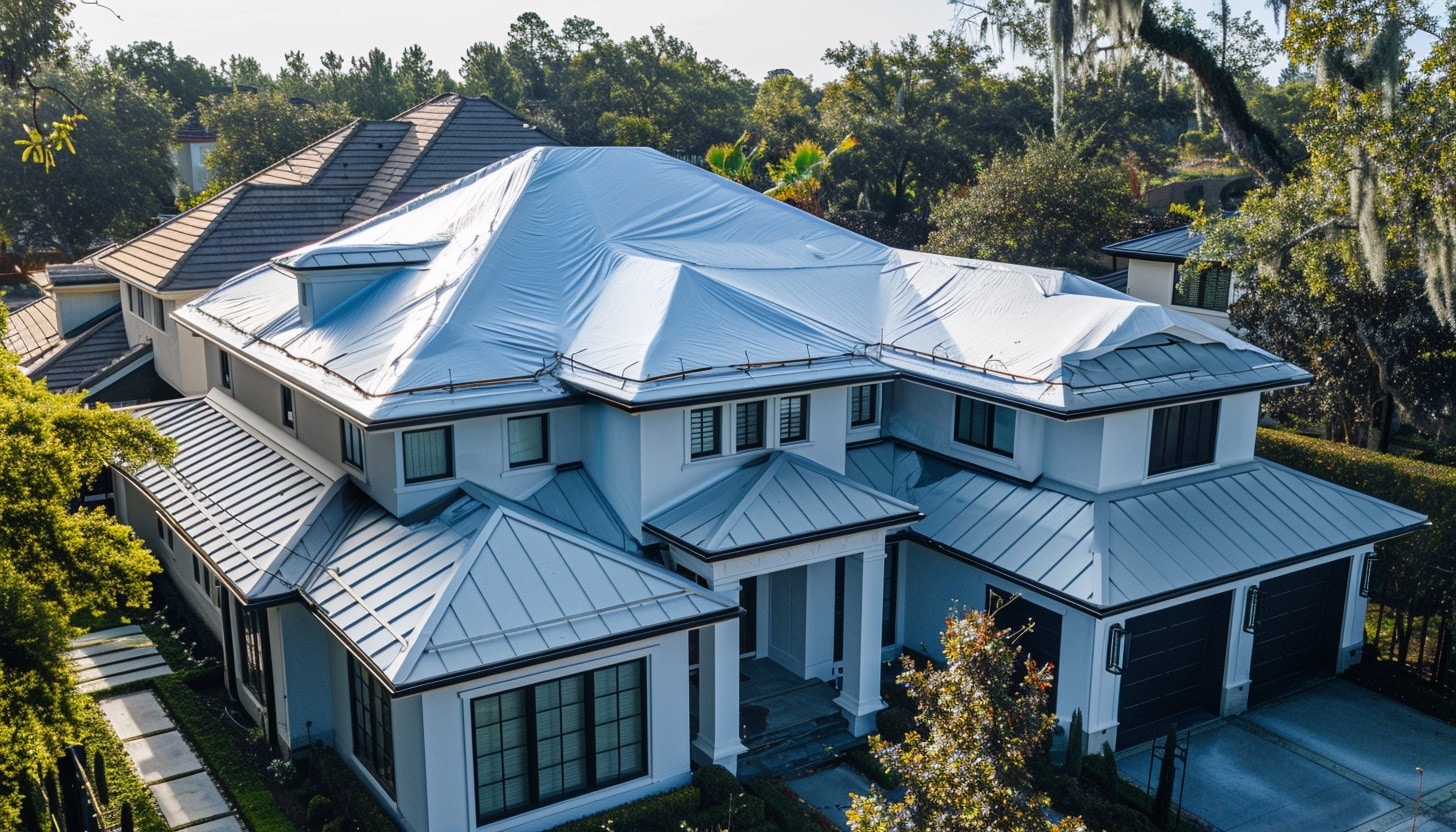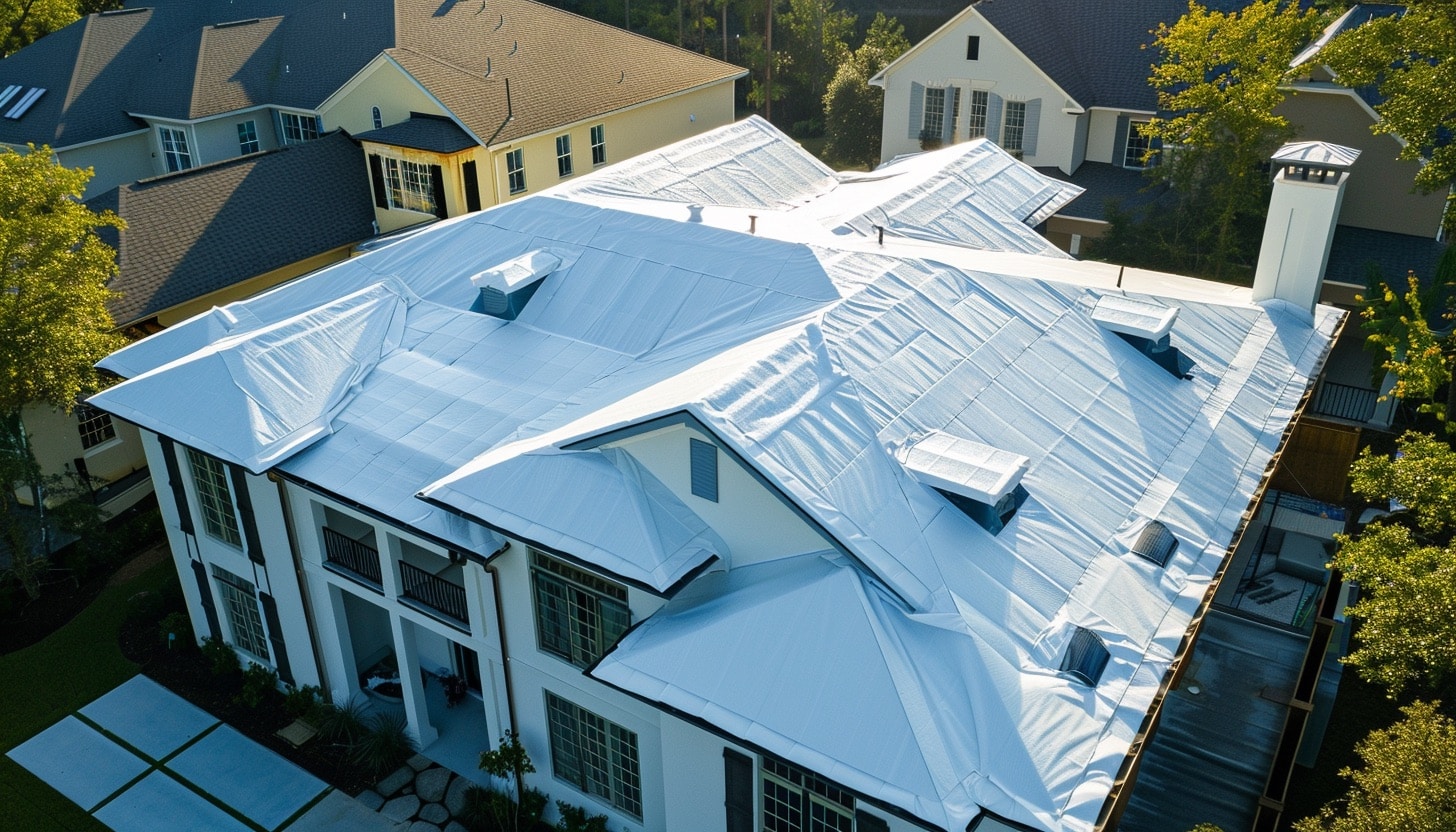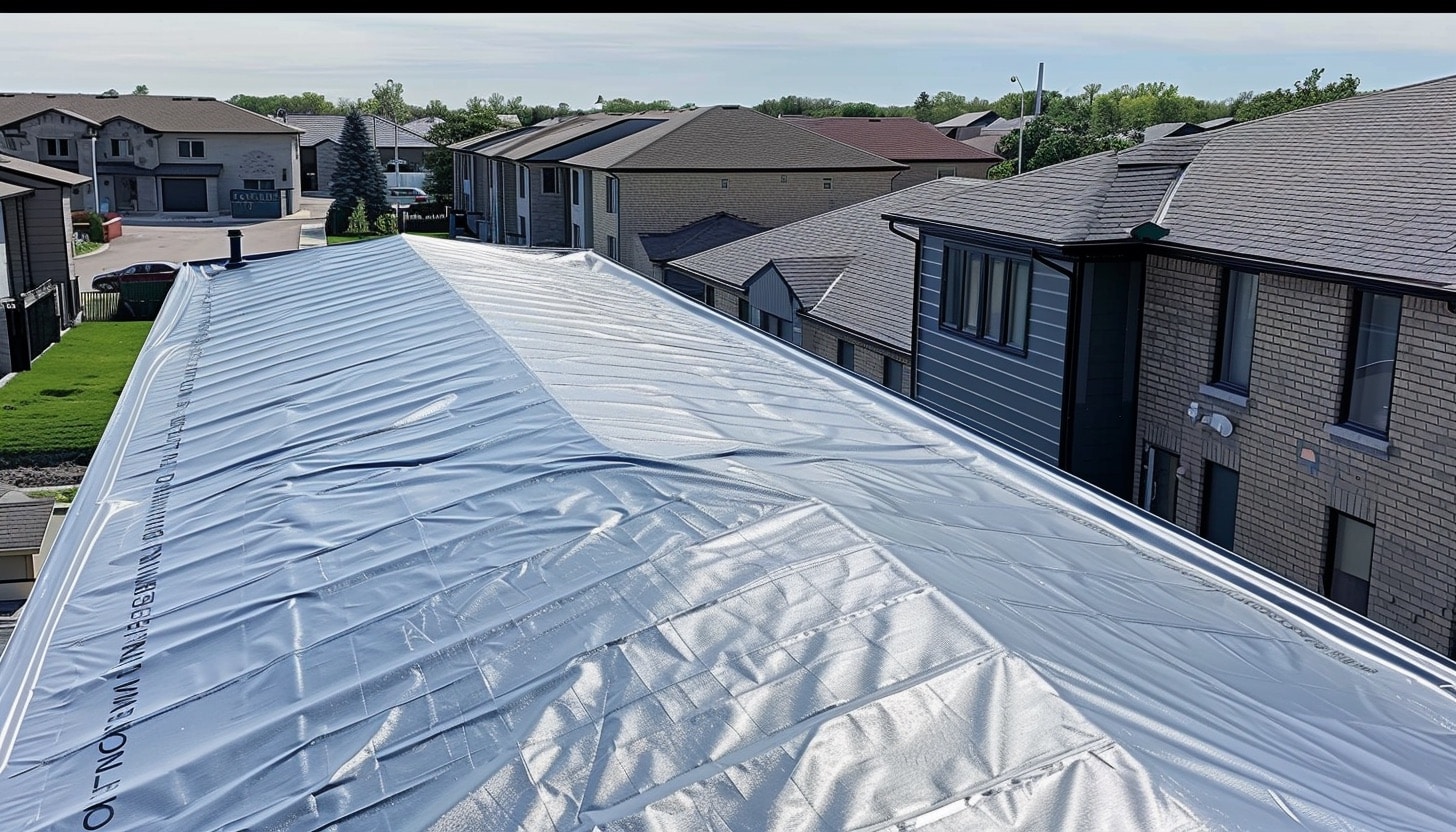Durability of Shrink Wrap Roofs: What You Should Know
Shrink wrap roofs have become an increasingly popular solution for temporary roofing needs, particularly in areas prone to severe weather events like hurricanes, heavy rain, and high winds. But how durable are these roofs? In this comprehensive guide, we’ll explore the durability of shrink wrap roofs, covering key aspects such as material resilience, installation techniques, and maintenance tips that ensure long-lasting protection.

What is a Shrink Wrap Roof?
Shrink wrap roofing involves applying a heat-shrunk plastic film over the roof, providing a protective barrier against the elements. This method is often used in emergency situations, such as after storm damage, to provide a temporary but highly effective solution until permanent repairs can be made.
Key Benefits of Shrink Wrap Roofs:
- Waterproofing: Offers excellent protection against water ingress, which is crucial in preventing further damage to the underlying structure.
- Wind Resistance: Designed to withstand high winds, with some installations enduring gusts up to 150 MPH.
- UV Protection: Shrink wrap materials are often treated to resist UV degradation, enhancing their durability in sun-exposed environments.
Durability Factors of Shrink Wrap Roofs
The durability of shrink wrap roofs depends on several factors, including the quality of the materials used, the installation process, and environmental conditions. Let’s delve deeper into each of these aspects.
1. Material Quality
The type of shrink wrap used plays a critical role in the roof’s durability. High-quality shrink wraps are made from robust, tear-resistant plastics that can withstand harsh conditions. These materials are also UV-stabilized, which prevents them from breaking down when exposed to sunlight over long periods.
Characteristics of Durable Shrink Wrap Materials:
- Tear Resistance: The ability to resist tearing, even when subjected to stress or sharp objects, is essential for maintaining the integrity of the roof.
- UV Stability: UV-stabilized materials do not degrade or lose their protective properties under intense sunlight.
- Heat-Sealable: The material should effectively bond under heat application, ensuring a secure and tight fit on the roof.
2. Installation Techniques
Proper installation is crucial for the longevity of a shrink wrap roof. Poor installation can lead to vulnerabilities, such as loose edges that can catch the wind or areas where water can seep through. The following installation steps are critical:
Key Installation Steps:
- Surface Preparation: The roof surface must be clean and free of debris to ensure the shrink wrap adheres properly.
- Application of Heat: The wrap is laid out over the roof and then heated, causing it to shrink tightly around the structure, creating a secure seal.
- Edge Securing: Edges should be tightly secured using battens or other anchoring methods to prevent wind from getting underneath.
Proper installation significantly enhances the roof’s ability to withstand environmental stresses, making it more durable.
3. Environmental Resistance
Shrink wrap roofs are designed to protect against various environmental factors. However, the extent of this protection depends on the specific conditions they face. Here’s how these roofs fare against common environmental challenges:
Resistance to Environmental Challenges:
- Wind: When correctly installed, shrink wrap roofs can resist winds up to 150 MPH. This makes them suitable for areas prone to hurricanes or strong storms.
- Water: These roofs offer excellent waterproofing, protecting the underlying structure from rain and leaks.
- Temperature Extremes: Shrink wraps are designed to withstand significant temperature fluctuations without becoming brittle or losing their elasticity.

Maintenance and Longevity of Shrink Wrap Roofs
While shrink wrap roofs are designed for temporary use, proper maintenance can extend their lifespan significantly. Regular inspections and timely repairs are crucial for maintaining the roof’s integrity.
1. Regular Inspections
Frequent inspections help identify potential issues before they lead to more significant problems. Inspections should focus on checking for tears, loosening at the edges, or areas where the shrink wrap may be lifting.
Inspection Checklist:
- Tears and Holes: Inspect the entire surface for any signs of tearing or puncturing.
- Edge Integrity: Ensure that all edges are still securely fastened and have not begun to lift.
- UV Degradation: Look for signs of UV damage, such as discoloration or brittleness, particularly in areas with intense sun exposure.
2. Timely Repairs
Small tears or loosened sections can often be repaired without needing to replace the entire shrink wrap. Using compatible repair materials, these areas can be resealed to restore the roof’s protective qualities.
Repair Methods:
- Patch Kits: For small tears, patch kits can be used to apply a new piece of shrink wrap over the damaged area.
- Edge Refastening: If edges begin to lift, they should be refastened using additional battens or adhesive materials.
3. Expected Lifespan
The expected lifespan of a shrink wrap roof typically ranges from 6 to 12 months, depending on the environmental conditions and the quality of the installation. In some cases, with careful maintenance, these roofs can last even longer, providing extended protection.
Longevity Tips:
- Avoid Physical Damage: Minimize foot traffic and avoid placing heavy objects on the roof to prevent damage.
- UV Protection: In regions with intense sunlight, consider using additional UV-resistant coatings to prolong the material’s life.
- Timely Replacement: When signs of significant wear appear, replace the shrink wrap to ensure continuous protection.

Advantages of Shrink Wrap Roofs Over Traditional Tarps
While traditional tarps are commonly used for temporary roof covering, shrink wrap roofs offer several advantages that make them a superior choice for long-term protection.
1. Better Fit and Seal
Shrink wrap provides a custom fit to the roof structure, which reduces the chances of wind getting underneath and causing the cover to lift or tear. The heat-shrinking process ensures a tight seal, offering superior protection against water ingress compared to loose-fitting tarps.
Advantages of a Custom Fit:
- Wind Resistance: A tight fit reduces the risk of wind damage, which is a common issue with traditional tarps.
- Leak Prevention: Shrink wrap’s custom fit minimizes gaps where water can enter, offering better protection against leaks.
2. Enhanced Durability
Shrink wrap is generally more durable than traditional tarps, especially in harsh weather conditions. The material’s thickness and tear resistance make it less likely to fail under stress, providing more reliable protection for extended periods.
Durability Comparisons:
- Material Strength: Shrink wraps are thicker and stronger than most tarps, which translates into better durability.
- Long-Term Use: While tarps are often intended for short-term use, shrink wraps are designed to last longer, even in challenging environments.
3. Aesthetics and Property Value
In addition to practical benefits, shrink wrap roofs also offer aesthetic advantages. A neatly applied shrink wrap can enhance the appearance of a property, which is particularly important in commercial settings or high-visibility residential areas.
Aesthetic Benefits:
- Neat Appearance: The clean, uniform look of shrink wrap is more aesthetically pleasing than the often wrinkled and uneven appearance of tarps.
- Property Value: By protecting the property effectively and maintaining a neat appearance, shrink wrap can help preserve property value during repair processes.

FAQs About the Durability of Shrink Wrap Roofs
1. How long can a shrink wrap roof last?
Shrink wrap roofs typically last between 6 to 12 months, depending on the environmental conditions and maintenance. With proper care, they can sometimes last even longer.
2. Can shrink wrap roofs withstand high winds?
Yes, shrink wrap roofs are designed to withstand high winds, with some installations capable of enduring gusts up to 150 MPH when properly installed.
3. What maintenance is required for shrink wrap roofs?
Regular inspections and timely repairs are essential. Look for tears, loose edges, and signs of UV degradation to maintain the roof’s integrity.
4. How does shrink wrap compare to traditional tarps?
Shrink wrap offers a tighter fit, better durability, and enhanced aesthetics compared to traditional tarps, making it a superior choice for long-term temporary roofing.
5. Can shrink wrap be used on all types of roofs?
Shrink wrap can be applied to most roof types, but the specific roof structure and condition should be evaluated to ensure proper adhesion and effectiveness.
6. Is shrink wrap environmentally friendly?
Shrink wrap materials are typically made from plastic, which is not biodegradable. However, some manufacturers offer recyclable options. It’s important to consider the environmental impact and dispose of the material properly after use.

 (832) 944-7663
(832) 944-7663